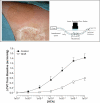Cutaneous vascular and sudomotor responses in human skin grafts
- PMID: 20558761
- PMCID: PMC2980376
- DOI: 10.1152/japplphysiol.00466.2010
Cutaneous vascular and sudomotor responses in human skin grafts
Abstract
Each year millions of individuals sustain burns. Within the US 40,000-70,000 individuals are hospitalized for burn-related injuries, some of which are quite severe, requiring skin grafting. The grafting procedure disrupts neural and vascular connections between the host site and the graft, both of which are necessary for that region of skin to contribute to temperature regulation. With the use of relatively modern techniques such as laser-Doppler flowmetry and intradermal microdialysis, a wealth of information has become available regarding the consequences of skin grafting on heat dissipation and heat conservation mechanisms. The prevailing data suggest that cutaneous vasodilator capacity to an indirect heat stress (i.e., heating the individual but not the evaluated graft area) and a local heating stimulus (i.e., directly heating the graft area) is impaired in grafted skin. These impairments persist for ≥4 yr following the grafting procedures and are perhaps permanent. The capacity for grafted skin to vasodilate to an endothelial-dependent vasodilator is likewise impaired, whereas its capacity to vasodilate to an endothelial-independent vasodilator is generally preserved. Sweating responsiveness is minimal to nonexistent in grafted skin to both a whole body heat stress and local administration of the primary neurotransmitter responsible for stimulating sweat glands (i.e., acetylcholine). Likewise, there is no evidence that this absence of sweat gland responsiveness improves as the graft matures. In contrast to the heating stimuli, cutaneous vasoconstrictor responses to both indirect whole body cooling (i.e., exposing the individual to a cold stress but not at the evaluated graft area) and direct local cooling (i.e., directly cooling the graft area) are preserved in grafted skin as early as 5-9 mo postgrafting. If uninjured skin does not compensate for impaired heat dissipation of grafted skin, individuals having skin grafts encompassing significant fractions of their body surface area will be at a greater risk for a hyperthermic-related injury. Conversely, the prevailing data suggest that such individuals will not be at a greater risk of hypothermia upon exposure to cold environmental conditions.
Figures






Similar articles
-
Sustained impairments in cutaneous vasodilation and sweating in grafted skin following long-term recovery.J Burn Care Res. 2009 Jul-Aug;30(4):675-85. doi: 10.1097/BCR.0b013e3181abfd43. J Burn Care Res. 2009. PMID: 19506504 Free PMC article.
-
Skin grafting impairs postsynaptic cutaneous vasodilator and sweating responses.J Burn Care Res. 2007 May-Jun;28(3):435-41. doi: 10.1097/BCR.0B013E318053d32E. J Burn Care Res. 2007. PMID: 17438491 Free PMC article.
-
Post Junctional Sudomotor and Cutaneous Vascular Responses in Noninjured Skin Following Heat Acclimation in Burn Survivors.J Burn Care Res. 2017 Jan/Feb;38(1):e284-e292. doi: 10.1097/BCR.0000000000000372. J Burn Care Res. 2017. PMID: 27359190 Free PMC article.
-
Responses to hyperthermia. Optimizing heat dissipation by convection and evaporation: Neural control of skin blood flow and sweating in humans.Auton Neurosci. 2016 Apr;196:25-36. doi: 10.1016/j.autneu.2016.01.002. Epub 2016 Jan 21. Auton Neurosci. 2016. PMID: 26830064 Review.
-
Mechanisms and modifiers of reflex induced cutaneous vasodilation and vasoconstriction in humans.J Appl Physiol (1985). 2010 Oct;109(4):1221-8. doi: 10.1152/japplphysiol.00298.2010. Epub 2010 May 6. J Appl Physiol (1985). 2010. PMID: 20448028 Free PMC article. Review.
Cited by
-
Heat-related issues and practical applications for Paralympic athletes at Tokyo 2020.Temperature (Austin). 2019 Jun 27;7(1):37-57. doi: 10.1080/23328940.2019.1617030. eCollection 2020. Temperature (Austin). 2019. PMID: 32166104 Free PMC article. Review.
-
First pregnancies, live birth, and in vitro fertilization outcomes after transplantation of frozen-banked ovarian tissue with a human extracellular matrix scaffold using robot-assisted minimally invasive surgery.Am J Obstet Gynecol. 2016 Jan;214(1):94.e1-9. doi: 10.1016/j.ajog.2015.10.001. Epub 2015 Nov 18. Am J Obstet Gynecol. 2016. PMID: 26601616 Free PMC article.
-
Prehospital management of exertional heat stroke at sports competitions for Paralympic athletes.Br J Sports Med. 2022 Jun;56(11):599-604. doi: 10.1136/bjsports-2021-104786. Epub 2021 Oct 7. Br J Sports Med. 2022. PMID: 34620604 Free PMC article.
-
Burn size and environmental conditions modify thermoregulatory responses to exercise in burn survivors.J Burn Care Res. 2024 Jan 5;45(1):227-233. doi: 10.1093/jbcr/irad128. J Burn Care Res. 2024. PMID: 37615621 Free PMC article.
-
Physiological Considerations to Support Podium Performance in Para-Athletes.Front Rehabil Sci. 2021 Nov 16;2:732342. doi: 10.3389/fresc.2021.732342. eCollection 2021. Front Rehabil Sci. 2021. PMID: 36188768 Free PMC article. Review.
References
-
- Ablove RH, Howell RM. The physiology and technique of skin grafting. Hand Clin 13: 163–173, 1997 - PubMed
-
- American Burn Association American Burn Association National Burn Repository (2006 Report). Chicago, IL: American Burn Association, 2007
-
- Anonymous Ambulatory and Inpatient Procedures in the United States, 1996. Washington, DC: Center for Disease Control and Prevention, 1998
-
- Austin KG, Hansbrough JF, Dore C, Noordenbos J, Buono MJ. Thermoregulation in burn patients during exercise. J Burn Care Rehabil 24: 9–14, 2003 - PubMed
-
- Ben-Simchon C, Tsur H, Keren G, Epstein Y, Shapiro Y. Heat tolerance in patients with extensive healed burns. Plast Reconstr Surg 67: 499–504, 1981 - PubMed
Publication types
MeSH terms
Grants and funding
LinkOut - more resources
Full Text Sources
Medical

